#porous structures
Explore tagged Tumblr posts
Text
vampire show!
#s2 so good. s2 fun. s2 doing interesting things with performance + complicity + lestat's makeup#louis' porous memory! armand's bitchy little faces at daniel! flinging myself on the FLOOR. assad zaman is a genius#there's so much mirroring from s1 to s2 & reframing is the structural theme. cinema
4 notes
·
View notes
Text
How to Safeguard Your Home Interiors During Flood Situations?
Floods can wreak havoc on homes, especially when it comes to interiors. Furniture, cabinets, and fixtures are often the first casualties, leading to significant damage and costly repairs. However, with thoughtful planning and the right materials, you can design interiors that are resilient to water damage. Here are expert recommendations to protect and rescue your home interiors in flood-prone areas.
1. Use 0.8 Density Boards for Inner Cabinet Sections
The inner portions of cabinets are often the most susceptible to water damage due to their porous nature. Opting for boards with a density of 0.8 ensures better resistance against swelling and warping. These boards are less likely to absorb water, maintaining their structural integrity even during prolonged exposure to moisture.
2. Protect Doors and Exposed Sides with 3-Layer WPC Color Boards
Doors and exposed cabinet sides are frequently in contact with water during floods. Using 3-layer WPC (Wood Plastic Composite) color boards offers excellent water resistance. These boards are not only durable but also aesthetically pleasing, ensuring that your interiors remain stylish and functional even in challenging conditions.
3. Opt for Stainless Steel 304-Grade Hardware and Accessories
Floodwater can cause regular metal fittings and accessories to corrode or rust. Investing in stainless steel hardware of 304-grade ensures long-term durability and resistance to rust, even in high-moisture environments. This type of hardware is ideal for hinges, handles, and drawer slides, offering reliability and longevity.
4. Fully Factory-Built Interiors for Precision and Sealing
Factory-built interiors are crafted under controlled conditions, ensuring precision and tight seals that can withstand water exposure. Unlike on-site installations, factory-made products are less prone to gaps and inconsistencies, providing better protection against water ingress.
5. Focus on Resilience Over Cosmetic Flaws
In flood-prone areas, it’s important to prioritize resilience over minor cosmetic imperfections like scratches or external strokes. By choosing materials and finishes designed to endure harsh conditions, you can safeguard up to 80% of your home interiors, minimizing losses during floods.
6. Use Elevated Furniture Designs
Opt for furniture with elevated designs that keep the base off the floor. Raised legs made of waterproof materials like metal or treated wood can protect your furniture from direct contact with water during floods.
7. Seal Wall and Floor Joints
Water often seeps through joints between walls and floors. Properly sealing these joints with waterproof sealants can reduce the risk of water ingress and damage to interiors.
8. Choose Water-Resistant Flooring Materials
Opt for flooring materials such as vitrified tiles, natural stone, or treated hardwood, which are more resistant to water damage. Avoid carpets or untreated wooden floors in flood-prone areas as they can absorb moisture and deteriorate quickly.
9. Install Water-Resistant Wall Cladding
Using water-resistant cladding materials like PVC panels or treated wood can protect your walls from moisture damage. These materials are easy to clean and maintain, even after exposure to floodwaters.
10. Incorporate Modular Furniture
Modular furniture, crafted with water-resistant materials, can be easily moved or lifted during flooding. These designs are not only practical but also add flexibility to your interior layout.
11. Use Waterproof Paints and Finishes
Applying waterproof paints and finishes to walls and furniture can create an additional layer of protection against water damage. These coatings can help prevent swelling, peeling, and discoloration caused by prolonged exposure to moisture.
12. Invest in Floating Shelves and Wall-Mounted Units
Floating shelves and wall-mounted cabinets keep valuables and essentials above potential flood levels. These features ensure that important items remain safe and accessible during flood situations.
13. Reinforce Baseboards and Skirting with Waterproof Materials
Floodwater often damages baseboards and skirting, leading to costly repairs. Reinforcing these areas with waterproof materials like PVC or treated wood can significantly reduce the impact of water exposure.
14. Choose Compact and Minimalist Designs
Compact and minimalist furniture designs are easier to move and protect during floods. This approach also reduces the number of items susceptible to damage, making cleanup and recovery quicker and more efficient.
15. Install Built-In Storage with Raised Bases
Built-in storage solutions, such as wardrobes and cabinets with raised bases, keep contents above flood levels. Elevated designs provide added security for stored items, minimizing damage to valuables.
Final Thoughts
Flood-resistant interiors are not just about damage control; they’re about peace of mind. By incorporating these strategies and materials into your home design, you can significantly reduce the impact of floods on your living space. Preparing for the unexpected is the key to ensuring your home remains a sanctuary, no matter the weather.
For more expert advice and solutions tailored to your needs, reach out to professional interior designers who specialize in resilient home designs
#furniture#kerala#interior designer kerala#interior design#Floods can wreak havoc on homes#especially when it comes to interiors. Furniture#cabinets#and fixtures are often the first casualties#leading to significant damage and costly repairs. However#with thoughtful planning and the right materials#you can design interiors that are resilient to water damage. Here are expert recommendations to protect and rescue your home interiors in f#1. Use 0.8 Density Boards for Inner Cabinet Sections#The inner portions of cabinets are often the most susceptible to water damage due to their porous nature. Opting for boards with a density#maintaining their structural integrity even during prolonged exposure to moisture.#2. Protect Doors and Exposed Sides with 3-Layer WPC Color Boards#Doors and exposed cabinet sides are frequently in contact with water during floods. Using 3-layer WPC (Wood Plastic Composite) color boards#ensuring that your interiors remain stylish and functional even in challenging conditions.#3. Opt for Stainless Steel 304-Grade Hardware and Accessories#Floodwater can cause regular metal fittings and accessories to corrode or rust. Investing in stainless steel hardware of 304-grade ensures#even in high-moisture environments. This type of hardware is ideal for hinges#handles#and drawer slides#offering reliability and longevity.#4. Fully Factory-Built Interiors for Precision and Sealing#Factory-built interiors are crafted under controlled conditions#ensuring precision and tight seals that can withstand water exposure. Unlike on-site installations#factory-made products are less prone to gaps and inconsistencies#providing better protection against water ingress.#5. Focus on Resilience Over Cosmetic Flaws#In flood-prone areas
0 notes
Text
Nah, there is not one word on how Severus smells like in the books. But jkr wrote that he smells like "bitterness and old shoes" in her twitter I think. What does "bitterness" mean, though, I have no idea – maybe this means potions? Like bitter herbs? Or cigarettes? I am also not sure how do old shoes smell and what type of shoes she means, like my boots (espesially when thinking about a rather vintage pair i have) smell of my shoe cream and a bit of leather.
But in the books themselves there is no info on that. Which also means that Snape was clean, and his greasy hair just means it was greasy, not dirty – I've never understood how do people believe he struggled with hygiene if he works with dead animals and their internal organs all day and other stuff like that.
*SLAMS HANDS ON TABLE*
ALRIGHT BITCHES LETS TALK ABOUT THE WAY SEVERUS SMELLS
While reading and writing Severus Snape fanfiction I've noticed no one has a full idea of what he smells like and honestly that is fair.
there is a tldr at the end for the people who don't want to here the rant!
I've seen a lot of people say his main scent node would be sandalwood and HONESTLYYYY I don't think that's accurate. Severus in all accounts does not take care of himself past basic hygiene niceties something like applying a cologne would not be there??
Sure there is an innate musk from his shampoo and body washes (which i think he makes himself but that's more of a doesn't want to spend money when HE HAS PERFECTLY GOOD INGRIDENTS TO MAKE WHAT HE NEEDS RIGH THERE but like i don't think he puts fragrance into them it isn't needed he just needs it to clean him not make him smell good)
SO LIKE HERE IS WHAT I DO THINK HE SMELLS LIKE IN LIKE STRONGEST TO WEAKEST??
Tea
-a self made blend of Chamomile mint and clove-
I've always head cannoned he drinks a lot of it. not because haha British but because it preoccupies him while others are talking so he can note things for future use. I think he makes his own blend because since he is constantly growing herbs and foraging it for potion making it becomes cheaper to just dry out and make your own (i also think he gifts his tea blend at yule time). I think he only makes calming teas. Being around people all the time when its very clear he doesn't want to be you need something to stay calm while there are calming droughts and other potions its widely assumed they can be addictive and yes he could probably make a non addictive version he doesn't have the time. So tea. Chamomile and mint have always been noted to calm nerves and i feel like the clove adds some spice that he enjoys.
Potions / potion ingredients
There are to many to list honestly.
Just in general you can assume the one person making potions for self research, constantly in a class teaching with varying ingredients, Brewing for The castles Medi-wing. Then in the later portion of the story TWO sides of the war. smells like a varying array of ingredients.
It could be said that the smells changes seasonally.
During the fall months he may smell more of ingredients themselves as he would've had to prep certain things that cannot be bought (or are not up to his standard at an apothecary) Yet, during the winter months when flu season is happening the lingering scent of brewed pepper up because those snot nosed kids sure as hell cant make it themselves. Spring would be whatever his classes are working on he wouldn't have time to do any research.
Summer though, Summer i think is when that smell changes the most. There are no kids he needs to brew for right away so he can focus on whatever potion he wishes to improve or outright create he can work with more dangerous ingredients.
That changes during the war of course he now has the workload from voldy and than we can assume he is at least brewing wolfsbane monthly for the order (the snupin shipper in me wishes to think he started brewing it during Remus tenure as the DADA teacher and just never stopped. he constantly badgers Remus for his new address to ensure he takes the potion to stop that daft wolf from doing anything idiotic it just becomes easier when he knows that he would be at grimmuald place) And than whatever they need for "war purposes".
Lavender
now hold on i thought you said he wouldn't use any cologne or anything like that. YES BUT i think he would use lavender in floral form or in oil for as a calming agent to sleep. I think this would've started when he was young possibly something his mother would do to soothe nightmares, (a sprig under his pillow or a dab of oil into the case itself) and he carried that on when he went to Hogwarts later when he returned to teach mentioning it in passing to Pamona and she gifts him new sprigs and oils for yule every year.
Tabaco
This one is honestly pure head cannon. But it makes sense to me he was raised in a coal town were he was constantly surrounded by booze and smokes. He would've picked up at least one of those habits and seeing his dad and the at the time normality of smoking yeah he would've done it. I think he quit for a while keep a pack tucked into his drawers in case he had a really bad teaching day and needed a hit of nicotine to make him not throttle anyone. But when both wars where happening i think he allowed himself to just smoke. Smoke when he wanted smoke to numb himself to whatever remarks were made about him at any meeting he showed too. Its a vice we all need one and i think its his.
SO YEAH.
I think he just naturally smells more floral and herbal than "woodsy" he may have a bottle or two of more masculine scents he was given from the Malfoys that he wears when forced into social events or when they are around him. But given what we know i think it wouldn't be sandalwood or driftwood whiskeys or scotch etc. (I'm also in the head cannon while he owns booze he doesn't drink often for fear of becoming his dad)
TLDR: I think Severus Snape smells mostly of Tea, Potions/Potion ingredients Lavender and Tabaco.
WHAT DO YOU ALL THINK I WOULD LOVE TO KNOW
<3
#severus snape#pro severus snape#also ofc if he wears any natural leather in the damp humid dungeons it's smell will intensify#and it tends to absorb different odours too because the structure of the material is porous#but idk what kind of shoes Severus would wear honestly
125 notes
·
View notes
Text

Presenting CERA MICROSEAL: Harnessing the Potential of Waterproofing Excellence!
💧 Experience the magic of CERA MICROSEAL, a specially formulated co-polymer-based integral waterproofing compound for cement mortar and concrete. It works wonders by reducing water demand and enhancing impermeability.
✨ Advantages that make CERA MICROSEAL stand out:
Enjoy excellent water resistance, safeguarding your structures.
Reduce shrinkage cracks in joints and plaster, ensuring long-lasting durability.
Maintain the optimal setting time of cement, without any adverse effects.
Reduce the water requirement of concrete and mortar mixes while maintaining workability.
Improve the bond strength of mortar to porous substrates like brick and old concrete.
Decrease permeability and water absorption of concrete and mortar, without compromising strength.
💪 Don't settle for ordinary cement modifiers. Choose CERA MICROSEAL for exceptional results and reliable protection.
📞 Contact us now and embrace the power of CERA MICROSEAL!
E-mail us at: [email protected] or contact us at 098404 80307
Cerachem #CERAMICROSEAL #Constructionchemicals #Environmentalfriendly #innovation #Economical #WaterproofingAdvantages #Durability #Protection #BuildingMaterials #Tileadhesives #Jointfillers #Drymixmortars #Waterproofingsystems #Admixtures #Repairrehabilitation #Flooringsystem #Protectivecoating #Marblerenewal #Sealercoats #ConstructionAids #Waterproofing #ConcreteEnhancement #ProtectiveCoating #ConcreteProtection #HighPerformanceFlooring #EnvironmentallyFriendlySolutions #TileGrout #EnhancedTileExperience #EnhancedBonding #ConcreteSolutions #FlexibleSurface #WaterproofingSolutions
#Presenting CERA MICROSEAL: Harnessing the Potential of Waterproofing Excellence!#💧 Experience the magic of CERA MICROSEAL#a specially formulated co-polymer-based integral waterproofing compound for cement mortar and concrete. It works wonders by reducing water#✨ Advantages that make CERA MICROSEAL stand out:#- Enjoy excellent water resistance#safeguarding your structures.#- Reduce shrinkage cracks in joints and plaster#ensuring long-lasting durability.#- Maintain the optimal setting time of cement#without any adverse effects.#- Reduce the water requirement of concrete and mortar mixes while maintaining workability.#- Improve the bond strength of mortar to porous substrates like brick and old concrete.#- Decrease permeability and water absorption of concrete and mortar#without compromising strength.#💪 Don't settle for ordinary cement modifiers. Choose CERA MICROSEAL for exceptional results and reliable protection.#📞 Contact us now and embrace the power of CERA MICROSEAL!#E-mail us at: [email protected] or#contact us at 098404 80307#Cerachem#CERAMICROSEAL#Constructionchemicals#Environmentalfriendly#innovation#Economical#WaterproofingAdvantages#Durability#Protection#BuildingMaterials#Tileadhesives#Jointfillers
0 notes
Text
I'm back from the rock show! Here are the Cool Rocks I got!
Let's start with the fossils this time.


This year I finally tracked down a Tully Monster, which is my state fossil! He's not a complete fossil, but you can see his eyestalk and the bottom of his proboscis very clearly.

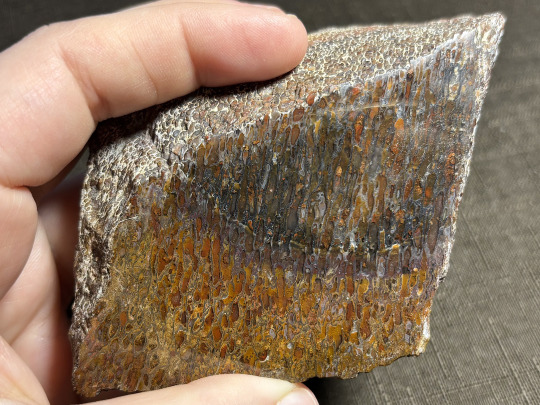
A big chunk of dinosaur bone from Utah! Dino bone is easy to ID due to its distinct pattern, where agate and jasper have filled in the porous structure of the bone.

This is a coprolite, a piece of fossilized dinosaur poop! This one is from Madagascar.

This one is a stromatolite, a rock formation created by a colony of bacteria! Stromatolites are some of the oldest fossils on Earth. In fact, the microbes that make them were likely the very first lifeforms on the planet. And they're still around today, mostly unchanged from their ancient ancestors, and still making rock formations! This little stromatolite came from Madagascar.

A giant chunk of Turritella agate, which I won at the silent auction! Turritella agate is made of a bunch of fossilized snail shells all packed together and filled in with agate. (Despite the name, they're not actually Turritella snails, but rather Elimia tenera.) When cut and polished, it reveals beautiful organic patterns. This stuff comes from Wyoming.
That's all the fossils I brought home! Now on to the minerals!

I was very responsible and didn't come home with a million agates this year, but I couldn't resist this gorgeous rain flower agate! Hailing from Nanijing, China, these agates are naturally polished by the Yangtze River and have a unique, frosted finish.

Another cabochon for my cab collection! This is afghanite, a blue mineral that isn't related to the sodalite family, but likes to grow alongside it.

It fluoresces!


Vesuvianite, a mineral that gets its name because it was first discovered on the slopes of Mt. Vesuvius! The dark crystals growing on its surface are garnets. This piece is showing off a great example of vesuvianite's crystal habit and terminations.

A huge zircon crystal! Zircon is the oldest mineral on planet Earth. There's a deposit in Australia which has been radiometric dated to be about 4.4 billion years old! Not this guy, though. This one is from Pakistan.

It fluoresces!

An AMAZING specimen of anatase! It's extremely rare for anatase crystals to grow this large. In fact, the only other anatase crystals I've seen in person had to be viewed under a microscope!
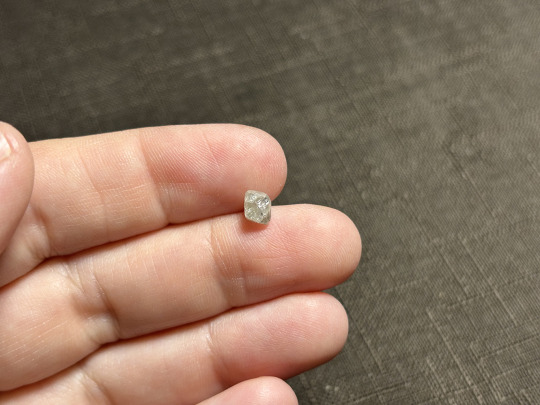
Here's the most expensive piece I came home with - a South African diamond! Can you believe I didn't have a diamond in my collection yet? That problem has been remedied.

It fluoresces!

And finally, my friends and I broke open a few geodes at the geode-cracking booth. I picked out some Trancas geodes from Mexico.




This locale produces weird, wavy, wormy crystals! These formations occur when quartz (in the form of chalcedony or hyalite) grows atop hair-thin, curly crystals of anhydrite.

They fluoresce!
And that was my haul from the rock show!
#rock collecting#red pen has cool rocks#tully monster#dinosaur bone#coprolite#stromatolite#turritella agate#rain flower agate#afghanite#vesuvianite#zircon#anatase#diamond#geodes#fluorescence
345 notes
·
View notes
Note
Hi! Given the recent heatwave that has struck the part of the US where I live, I was wondering what Birgs do to keep cool on a hot day? I imagine that they don’t go for a swim given their dense coats.
Mostly, they just stay indoors. The high axial tilt of their world means that at the height of summer, the sun does not set for weeks or months depending on the latitude, leading to brutally hot summers in inland areas. Where the terrain allows it, thick earthen walls and subterranean rooms help inhabitants shelter from both extreme heat and cold. Sunken courtyards contain trees which filter incoming sunlight and slowly release moisture, keeping both the trunk below and any birgs nearby nice and cool.

Widely used in the Northern Landmass, wind catchers and roof vents establish a draft through the building, which are then paired with wet terracotta pipe structures to cool the passing air as water evaporates through the porous clay. Relatively cheap and easy to install in buildings that aren’t already sheltered by the ground itself.

#ask#FINALLY#posting birg content again#I’ve felt very uninspired for this setting lately but this was a good ask
406 notes
·
View notes
Text

I've seen sheriff's houses and old police stations with holding cells, but I've never seen a whole jailhouse converted to a home. This is so cool, but I have some concerns- it's a 1914 completely renovated jailhouse in Ozark, AR. 3bds, 2ba, 2,512 sq ft, $600k.


I love this old timeworn look. Here's the central hall entrance.


They did an open concept living area. Is this done correctly though? It looks like you wouldn't want to touch the walls.

The dining table between the living room and kitchen.

Here in the corner they've got a table for two so they can look out at the Arkansas River.


The description calls this a gourmet kitchen. The stove does look professional.
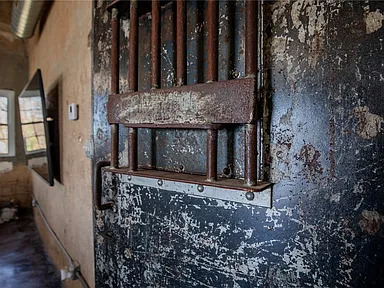
These doors.

Looks like some sort of work room.

In this shower room, is there some sort of sealant on the old floor? B/c I would have to wear flip flops in there- it looks kind of yucky and porous.

This is a small bedroom #1.

Down at the end of this hall of cells you can see bathroom #1 for the main floor. Are all the surfaces sealed? Shouldn't they be?

Here we have the stairs to the upper level. Looks like a medieval castle door, doesn't it?

The stairs have a small landing, then lead to a long stairway.
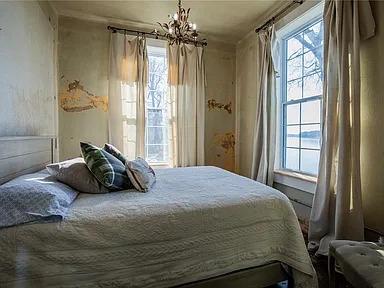
Bedroom #2 is also small.


The primary bedroom is the largest. Everything looks like it's going to continue to deteriorate.

Then, this is the 2nd bath, which is the largest. Geez, the floor looks so bad, and I see that they put in a square of cement. But, what about the wall and floor in the shower?

It also has the washer/dryer in here.
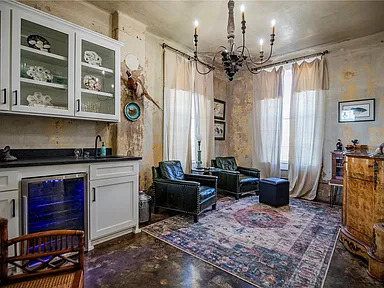

They made this room a family room with a kitchenette in the corner. (If the place is haunted, you wouldn't want to go downstairs at night to get a snack.)


The 1,537.67 sq ft lot is right next to the railroad tracks and on the banks of the river.

There's a great view of the bridge.

And, the river. I noticed, on the map, that the U.S. Army Corps of Engineers is nearby. I wonder if they would answer any questions the new buyer would have about structure, lead, the river overflowing, etc. (I mean, I live on the banks of a river and they came & installed this massive "thing" to finally stop it from overflowing.)
https://www.zillow.com/homedetails/209-W-River-St-Ozark-AR-72949/2068714482_zpid/?
#old jail conversion#historic jailhouse conversion#unique homes#houses#house tours#home tour#homes under $625k
127 notes
·
View notes
Text
Paleo-caves in Death Valley
You have probably heard of "caves", or a natural void formed in rock. Caves are formed in a number of ways, but the most familiar are probably those formed in limestone - called karst or karstic. Karst caves are formed by the steady dissolving of limestone rock by naturally acidic groundwater percolating through the ground, often along faults or other natural weak areas.
Death Valley in California is not a hotbed of limestone caves, though evidence of them can be seen in a number of places! Ancient caves, often tens or hundreds of millions of years old, sometimes collapse or fill in with silt/minerals/debris. An ancient cave formation is called "paleokarst", and there are a few areas in Death Valley where you can find it. The easiest to access is in Titus Canyon, a major canyon who's lowest reach carves its way through limestone bedrock, leaving behind towering polished rock walls and revealing the internal structure of the rock.

Titus Canyon's narrow section is carved through the Bonanza King Formation, a Cambrian-age (538 - 485 million years ago) marine sedimentary rock package several kilometers thick. It's found in many areas of Death Valley and the surrounding region. Across its area and thickness, it alternates from dolomite to limestone (dolomite minerals versus calcite minerals). Dolomite doesn't usually dissolve and form caves, but limestone does - and the many fractures in this rock appear to have allowed numerous tiny caves to form somewhere in the distant past. Most of these have since been filled in with calcite minerals, making them paleokarst.

In this image, you can see the void of the cave lined with thinly-layered calcite. It has a flat floor, and these features are characteristic of having formed in a cave. In Titus Canyon, we can find these from a few inches to a few meters across, and as the canyon has been carved into the rock, these voids are exposed. This one below tells an exceptionally clear story:

You don't need to be a geologist to see how this differs from the first example. There's a weird pendant-shaped protrusion hanging from the top, there are layers in the minerals, the bottom half is red… there's a lot going on. Let's get some lines on there and figure out what we can see:

That's better. OK - I've separated out the parts of this outcrop which from my desk look to be distinct. Here's a close-up of part of the left-center area to show how it appears different up close.

OK, so we have the blue-gray limestone bedrock on the right, top, and lower left, then a gray-red area with layers and what looks like gravel or other angular pieces of the limestone. Above that is a finely-layered calcite deposit (remember? that's cave-like!), and above that is a layer of calcite which is rather porous. The top surface of this area is sort of scalloped and curved, which is also characteristic of limestone caves.

Here's the fully interpreted version. Let's go through the sequence of events. First, we have the limestone bedrock of the Bonanza King Formation (BKL). At some time in the distant past, a portion of it dissolved away and formed a cave. Over time, silt and debris filled in the bottom of this cave. Because it is ancient, we call it paleo-fill (OPF). This might have happened at a time when the cave was dry (not containing water), since if it was wet we would expect some amount of calcite to be deposited around its perimeter as is typical in limestone caves.
Above that is a layer of thinly-layered calcite, the cave mineral. This layer contains some reddish silt and the occasional fragment of the limestone, so the cave was probably happily active during the time that was deposited! This is the oldest cave mineralization phase I can discern in this outcrop, so I call it Old Cave Calcite (OCC).
Next, we have a slightly porous, light-colored calcite deposit. The porosity suggests to me that it was deposited faster, but I am not an expert on cave deposits so will not comment further. This unit fills the cave to its top in most places! I call this the Middle-age cave calcite (MAC).
Finally, the youngest unit is another cave-deposited calcite (YCC). As in the first cave picture above, it is a coarser-grained pale yellow color with layers that parallel the sides of the void. Most of the paleo-caves you can find in Titus Canyon are filled with this sort of calcite, and it may be geologically recent (last million years?). It filled the final remnant of this ancient paleo-cave, and is contrasting with the material around it. This visual and textural contrast is what inspired me to write this post in the first place - the best example I've seen in person of paleo-karst and the evolution of a miniature cave system, right in the heart of Death Valley - my favorite place in the world.
#geology#photography#adventures#bettergeology#california#rocks#death valley#death valley national park#cave#paleokarst#limestone#california geology#geologia#i love rocks
97 notes
·
View notes
Text
"The Cathedral of Robot Artisans"

Spatial Qualities: Dialogue Between Existing and New Structures
The project posed a complex challenge: to retrofit a 19th-century brick stable into a functional, contemporary fabrication space while preserving its historical integrity. Within a four-month timeframe, an international cohort of MAEBB (Master in Advanced Architecture and Biocities) students designed and built a hybrid structure that simultaneously honors traditional craftsmanship and embraces advanced digital fabrication.
At the heart of the project lies a tension between the old and the new, the solid and the porous, the static and the adaptive. The design retains the original brick walls, reinforcing them structurally while removing the decayed roof to introduce a new timber framework. This act of surgical preservation frames the contemporary intervention as both a response and a counterpoint to the pre-existing architecture.
Internally, the space is organized around the operational needs of the industrial robot. An open-span layout ensures unobstructed movement, while carefully positioned skylights and glazed openings allow natural light to penetrate the interior without compromising environmental control. Above the robot, a prominent skylight creates a dramatic shaft of light that recalls the sacred spatial strategies of ecclesiastical architecture, reinforcing the project’s metaphor of a “cathedral” for contemporary artisanship.
The spatial atmosphere is quiet and refined, a composition of filtered daylight, exposed timber, and restored masonry that balances technological precision with human engagement.
Materiality and Construction: Advanced Timber Engineering
Timber serves as the project’s primary material, chosen for its environmental performance, structural adaptability, and symbolic resonance with the surrounding landscape. A self-supporting arborescent structure, made from solid wood and Cross-Laminated Timber (CLT), defines the new roof and internal framework. Seven branching columns, reminiscent of tree trunks, hold aloft a Voronoi-patterned canopy, a formal language derived from nature but realized through digital craftsmanship....
58 notes
·
View notes
Text







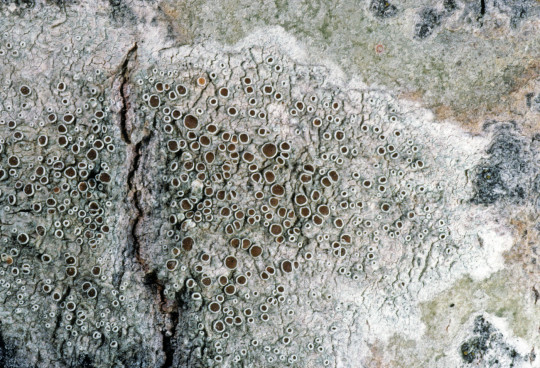
Lecanora allophana
Brown-eyed rim lichen
How to not fall in love with lichens:
1. Never look for them when out walking or sitting in a park or exploring castle ruin. Do not look for them on tree trunks or cliff sides or roofing tiles.
2. Do not get close to them. Do not get down on their level. Do not touch them. Do not pick them up and hold them gently in your hands. Do not whisper your secrets to them in the silence of the forest.
3. Stifle your curiosity. Try not to learn anything about lichens. Don't learn what the different structures are, or where they grow. And whatever you do, do NOT learn how to recognize common or local species.
4. Tune out the hum of the natural world pushing up against the porous, artificial veil separating humans from the ecosystem. Remember that we are not all products of the miracle that is evolution. We are humans, and we are superior, and we do not need care about any other life forms. Keep that in mind at all times.
images: source | source | source
#lichen#lichens#lichenology#lichenologist#mycology#ecology#biology#fungi#fungus#symbiosis#symbiotic organisms#algae#trypo#trypophobia#Lecanora allophana#Lecanora#I'm lichen it#lichen a day#daily lichen post#lichen subscribe
97 notes
·
View notes
Text
common misconception that jesus lives in your heart. jesi migrate to the heart for breeding season, but the environment is too erratic to live full time. full grown jesi actually inhabit the porous structure of your skeleton and feed on the calcium deposits. this is where osteoporosis comes from
54 notes
·
View notes
Text
By studying calcifying organisms, Leanne aims to better understand the impacts of human activity on marine ecosystems. Through her research, she hopes to influence policy that helps protect marine calcifiers in the future.
“Why is this important? The idea is that the more porous the shell, the weaker it is. Mussels need strong, robust shells to protect their inner soft organs—and that strong 3D structure is important for ecosystem function as habitat formers and storm defenses.
Currently, the changes seen in shell porosity are not large enough to influence the material properties, so we aren’t seeing weaker shells just yet. But with further warming in our oceans being predicted, this could potentially lead to even more porous shells, potentially impacting mussels’ function as habitat formers and storm defenses, as well as their ability to protect themselves from predation,” Melbourne explains.
Learn more about her research here.
#science#museum#amnh#natural history#nature#marine biology#marine ecosystem#mussels#bivalve#did you know#fact of the day#research#women in stem#climate change#conservation#earth month#earth day
380 notes
·
View notes
Text
What’s your favorite article the Bakers have written? Reblog this with a link to it, right now. Don’t have one? Then here’s your assignment: start reading. There’s an index at lumpley.games. None of them are enormously long, but take your time. Find the ones that interest you, or piss you off, or confuse you. Meditate on them for a couple of days. Let them affect you. Disagree, where you want. Write a game about it.
Then come back here, and reblog this with a link to your favorite.
For me, I think it has to be Meg’s article on Ritual in Game Design, where she offers both a practical ritual structure and a theoretical system for understanding what it is that rituals actually do. Or maybe my favorite is Vincent’s article on the philosophic fundamentals of Powered by the Apocalypse, especially Part 4 and the conversation about concentric design. Rituals in rituals. Games wrapped in games.
I’ve been thinking a lot about these two articles as I put together my reflections on the Dream Library’s monthlong discussion of Under Hollow Hills, one of—hands down—the best games of the last decade and arguably one of the best of all time. Under Hollow Hills is a game full of games: big games, small games, mortal games, fairy games. Games as brief as a single play, as long as a session, as eternal as death. Games that overlap and interlock and flow together in continually new and interesting ways. Some of my favorite moments in playing Under Hollow Hills are when I get to feel the games bleeding into each other. Sitting and listening to two players bicker in a session last month, I felt inclined to interrupt only when things got really heated:
“Greshkorn,” I said. “That’s an insult, if you like.”
“I know,” said Greshkorn the Boondoggle Hob. “I’m going to shrug it off.”
Each of the mechanical layers of Under Hollow Hills—the concentric circles of Vince’s article—is a game unto itself. Many of them have multiple games within them: little forms, conversational algorithms that will lead us to the next thing worth talking about, or the next little treasure to uncover and play out. Another word for these might be rituals.
Meg doesn’t give us an easily quotable definition of ritual in her article, but she does tell us that in order to be effective, a ritual must be intentional, contained, conscious, creative action. For a thorough breakdown on what she means by each of these terms, I really can’t suggest anything better than reading the article, but (to gloss them irresponsibly quickly) Meg’s “effective ritual” is in essence both set aside (intentional, contained, conscious) and willingly performative (conscious, creative, action). I use “performative” here in the Butlerian sense of active self-replication: by participation in ritual, we create ritual again. Its meaning comes from our making meaning of it, and our making meaning comes from our doing it, and we do it because it has meaning. If I wanted to be a little more “scholar of religion”* about all this, we could say that effective rituals are both sacred and magical. And magic is, as the poet wrote, fake as shit.
Why bother, then? Why create something special and set aside—and necessarily limiting and restrictive—when those limits are only given substance by our abiding by them? Why create social structures? Why play games?
Well, in the case of that last one: because they’re fun. Because effective ritual is effective. It has an effect. In the case of a game, that effect is fun.
Sometimes, people talk about play and games as though they were entirely separate from the real world: locked away within the much-discussed “magic circle” through which nothing can pass, and within which we are safe to explore worlds beyond our own. I’ll tell you, there’s only one person who has ever lived in a real magic circle: it’s that twink from Severance. A ritual without porous borders is nothing. It’s dead air. It’s a locked box. Why would we bother going on a journey if we weren’t going to come back a little different?��
The permeability of the magic circle is made obvious by the issue of bleed. Things are clearly coming back and forth across the border—out of the game—all the time! And, importantly: we want them to! We build boundary-rituals not to prevent transmission, but to structure it in a way which keeps us safe and happy—to let us visit the fairies without being trapped there forever.
I think the Bakers know this. The deep desire of fairyland is to go and return changed. J.R.R. Tolkein thought that change was necessarily restorative. It is not. There are many games fairies play, and some are downright perilous. Why else would Puck apologize? Because he knows the stakes of play. Maybe, if we call that a dream—or a fantasy, or a fairy-story, or a game—it will make our position a little bit less frightening. At very least, we’ll tip better.
Under Hollow Hills is a game full of games. We would be foolish to think that we could play them unchanged. But we would be equally foolish to think that our own plasticity means these rituals are no longer “play.” After all, we change. That’s the game.
This month (February) the Dream Library is moving on to another fairy-game with Under Hill, By Water, an OSR-adjacent game of hobbit-trouble. If you're interested, come along and join.
* I had a big old paragraph here I decided to cut from my rambling, about A.J. Heschel and the “palace in time.” If you want to hear more about that, come and ask.
66 notes
·
View notes
Text
Gram-positive vs. Gram-negative bacteria
a.k.a. the inspiration for this blog's icon
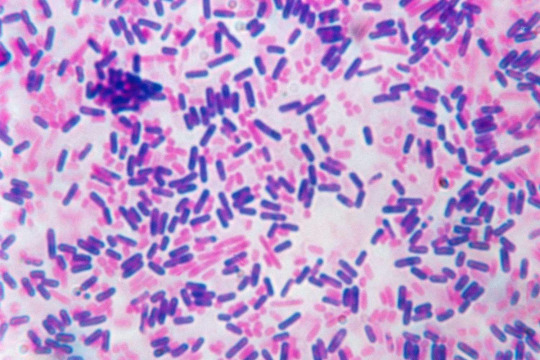
When researching your favorite species of bacteria, the first characteristic you're guaranteed to find is whether or not your bacteria is gram-positive or gram-negative. This is in reference to the Gram stain, a method of staining bacteria with dye, such that certain bacteria retain it and become purple (gram-positive), while others do not -- and after an alcohol wash, can be tinted pink with a counterstain (gram-negative). This staining procedure is almost always the first step in figuring out what kind of bacteria you're working with, and is used constantly for both clinical and research purposes.
Okay, but why? And why does the color of a dyed bacterium even matter?
The answer to these questions... lies in the structure of the cell wall. Gram-positive bacteria retain dye because their cell walls are much thicker. The typical gram-positive bacteria has one cell membrane, covered by a thick layer of peptidoglycan, which is a polysaccharide that gives structural strength to the cell. In contrast, the typical gram-negative bacteria has two cell membranes, separated by a thin layer of peptidoglycan: this layered structure is thinner and more flexible. Gram-negative bacteria can be counterstained because this outer membrane is porous, and is degraded by the alcohol wash, losing its ability to retain the original dye.
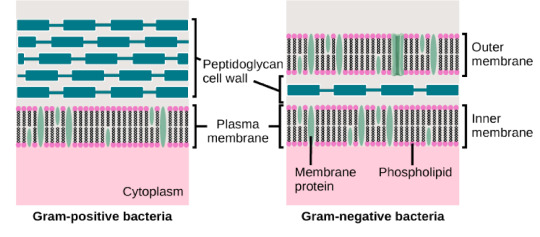
This difference in cell structure may not seem earth-shattering, but it does have some serious implications. For example, in medicine, you want to know if you're dealing with a gram-negative bacteria, because they are less susceptible to antibiotics that target the cell wall (such as penicillin): in essence, the outer membrane protects the cell. Penicillin can easily fit between the gaps in the peptidoglycan layer surrounding gram-positive cells, but not through the outer membrane of gram-negative cells, which selectively blocks the passage of toxic substances. In general, gram-negative bacteria are less vulnerable to environmental toxins.
Gram-positive bacteria have their own strengths. In fact, they have an extremely powerful tool at their disposal: unlike (almost all) gram-negative bacteria, some gram-positive bacteria are capable of forming endospores. Endospore formation is an intense survival mechanism where a bacterium creates a dormant structure inside itself (called an endospore), which is extremely durable but cannot self-replicate. When conditions have improved, the endospore transforms into a bacterium, and begins to metabolize and reproduce. Endospores can lie dormant for thousands -- and some argue, millions -- of years, and remain viable.
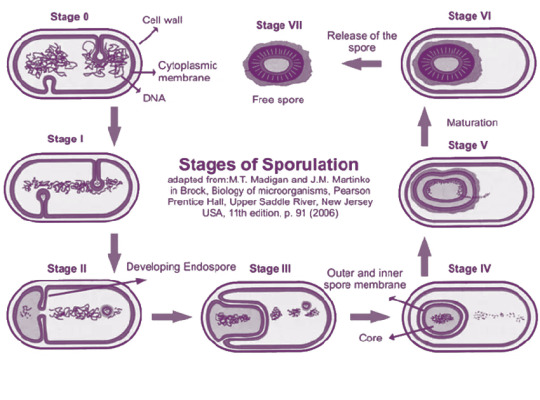
To summarize: what at first may seem like a simple question of microbial dye-jobs is actually a way to peer into the structure of a bacteria, and hopefully start to unravel the unique strategies and adaptations that the species employs for survival.
Happy Gram staining everyone!
269 notes
·
View notes
Text
A 'cage of cages' is how scientists have described a new type of porous material, unique in its molecular structure, that could be used to trap carbon dioxide and another, more potent greenhouse gas. Synthesized in the lab by researchers in the UK and China, the material is made in two steps, with reactions assembling triangular prism building blocks into larger, more symmetrical tetrahedral cages – producing the first molecular structure of its kind, the team claims. The resulting material, with its abundance of polar molecules, attracts and holds greenhouse gasses such as carbon dioxide (CO2) with strong affinity. It also showed excellent stability in water, which would be critical for its use in capturing carbon in industrial settings, from wet or humid gas streams.
Continue Reading.
#Science#Enviroment#Chemistry#Materials Science#Greenhouse Gasses#Climate Change#Supramolecular Self-Assembly#Molecules
145 notes
·
View notes
Text
Kryptonians: Fungal Analogues?
A semi-comprehensive study by Kitsu
X / Next ->
Overview: To analyse the anatomy and communal habits of the alien species Kryptona filius [Latin, Kryptona: <of> Krypton - native planet; filius: ‘child/son’ (Child of Krypton)], common name ‘Kryptonians’ for documentation and further research.
Krypton is a Planet with a red sun in Sector 1003 (see Green Lantern corps documentation), with a diverse biosphere and a highly intelligent dominant species. Kryptonians, as they have been named, look to be quite humanoid (bipedal with 4 limbs and a distinct cranial space). On a surface level, they appear to share physical traits with human kind, but that seems to be where their similarities end.
They show technological advancements beyond human levels, heirarchal systems, guilds and a well established henotheistic religious system.
[Rao-orthodox Religion, also known as Raoism for short, is the primary religion of Krypton. Adherents of this religion worship the god Rao, which is based on the planet’s sun. The religion also includes a pantheon of 14 major deities, 203 demigods, and over 1000 Titans. The religion’s main sacred text is ‘the Book of Rao’, which contains a wealth of religious and historical information.]
Running Hypothesis: Kryptonians have exhibited habits analogous to Earth-based fungal growth habits (reproductive and communal). Traits appear to be based on environmental factors (climatic conditions, food availability, cross species interactions, etc.), and can be pinpointed to certain specific fungal species.
It is to be noted that characteristics of multiple related or non-related fungi appear commonly in their species. Morphological differences within each community emerge from genetic mutations and extensive species isolation to their respective biome conditions.
Addressed topics: Anatomical and ethological topics to be covered as follows -
Organ systems (A) [Common features]
Morphological differences in isolated communities (A) [Biome-based classification]
Mode of nutrition and dietary habits (A)
Pathogenic resistance (A)
Cross-community interactions (C)
Parent-offspring relationships (C)
Heirarchal structures and Socio-politics (C)
Topic 1: Organ systems:
General overview of anatomy -
Kryptonians appear to share some morphological characteristics with humans and other alien species, specifically their neural network being largely concentrated in the head (cranium) and a similar facial structure. Studies have shown that the number of neural connections in the brain of an adult Kryptonian far surpasses the number of connections in a human adult (there are approx. 142 billion neurons in a Kryptonian brain as compared to the approx. 86 billion of a human). These connections appear to be heavily interlinked with each other, often overlapping and forming multiple associations (perhaps this explains their extraordinary memory). The synaptic plasticity of the Kryptonian brain is high, forming new connections and strengthening itself constantly.
For as advanced as the brain of a Kryptonian is, their body anatomy is much simpler and way more different than expected.
Respiratory system:
Kryptonians appear to not have a complex respiratory network, instead possessing something similar to amphibians and mushrooms.
The atmospheric composition of Krypton is found to largely be nitrogen [89%] followed by oxygen [10%] and other gases (Carbon dioxide, noble gases, water vapour, etc,.) [1%]. Kryptonian bodies appear to be aerobic, breathing mainly through thin layers of porous and delicate skin. The epidermis consists of a few tough, highly porous outer layers that protect the body from physical damage and thin inner layers capable of filtering impurities and unneeded molecules from the air taken in by the Kryptonian. The inner layers directly filter into their version of a circulatory system via diffusion.
The inner layers of skin are highly folded over one another to increase surface area for absorption, resembling the gills of a mushroom.
Considering the lack of a respiratory organ like the lung of a human, the presence of structures similar to nostrils on the ‘face’ of a Kryptonian stumps researchers. Some suggest a more direct and concentrated oxygen source to the neural network [the ‘nostrils’ are lined with multiple heavily folded layers of ‘gills’, twice more than other areas of the body], and it is the most accepted hypothesis.
(Case 1; Subject Kal-El:
- In the presence of a yellow sun [radiation], a Kryptonian's skin becomes impervious to physical damage and regenerates at a speed quadruple the original. Conversely, in the presence of Green Kryptonite [radioactive mineral - mainly emitting beta- and gamma-radiation; Kryptonian origin], the same skin deteriorates, losing its integrity and becoming weaker. Additionally, different variants of the Kryptonite seem to affect the skin differently. Further studies into these effects to be done.
- Krypton's atmospheric oxygen levels are very low when compared to that of Earth, which points to Kryptonians not being as dependent on oxygen as a human and/or possessing an extremely efficient respiratory system and cells that utilize the least oxygen possible. Upon analysis, Kal-El exhibits a higher reading of dissolved oxygen in the blood than strictly necessary. The effects of increased oxygen levels to be studied: potential for oxygen poisoning? Is the increased regeneration provided by the yellow sun responsible for uninterrupted life?)
Circulatory system:
Kryptonians lack complex networks of vessels that carry 'blood' to their cells; they lack a lymphocytic system all together. Their plasma-like fluid [water based, carrying proteins, hormones, enzymes, etc,.] flows freely into the coelom (i,e., fluid-filled body cavity) carrying dissolved oxygen and nutrients. This 'blood' lacks blood cells and platelets, distributing oxygen via wide-spread diffusion instead.
Despite lacking hemoglobin, Kryptonian blood appears red in colour due to the presence of a pigment atromentin [IUPAC name: (2,5-dihydroxy-3,6-bis(4-hydroxyphenyl)-1,4-benzoquinone)], a naturally occurring organic molecule found in Agaricomycetes fungi in the orders Agaricales and Thelephorales . It possesses properties similar to heparin, an anticoagulant used in medical practises.
<attached below: Chemical structure of atromentin>

<attached below: synthesis of atromentin and its derivatives>


Young Kryptonians show a bright red pigment while older Kryptonians show a duller, muted red. The corelation to their health is so far unknown.
Digestive system:
Kryptonians do not have a complex multi-organ system for digestion. Instead, they possess one dense, oddly crystalline organ in their torso that directly connects to their mouths via an oesophagus-like structure. This organ [now named 'The Core' for aesthetic purposes; the junior researchers were enthusiastic in naming it as such] contains highly destructive enzymes that are capable of digesting a vast array of materials harmful to other organisms with ease. Subject Kal-El has eaten various materials, including and not limited to: rocks, metal, uncooked meat, overcooked meat, radioactive materials (uranium, caesium), magma, etc,.
Each subspecies of Kryptonians exhibit different dietary habits based on their biomes and specific adaptations, which will be separately explored later on.
The core has separate sections that target specific nutrients, breaking them down and absorbing them, filtering directly into the circulatory system to be transported to the cells. The Kryptonian digestive system is very effective, producing very little in terms of food waste. The waste is transported to an organ analogous to the large intestine in function [aptly named the Intestine] and is excreted via an anal opening.
Kryptonians also seem to not produce nitrogen-based waste (ammonia, urea and uric acid), instead using them for growth and metabolism. They utilize specialized cells for nitrogen fixation, recycling the nitrogen compounds into compounds useful for the body. Whatever meagre amounts are left out are transported to the intestine and excreted with the food waste.
Nervous system:
Kryptonian bodies have a well developed nervous system, consisting of specialized nerve cells that react to stimulus and pain. The receptors for pain appear to be less sensitive than those of a human, pointing towards a different pain threshold for the species.
The Central Nervous system is analogous to the human CNS, perhaps even more advanced. The Peripheral Nervous system is widespread and lightning quick, allowing for extremely fast reflexes, extreme control of bodily functions and heightened senses for survival.
(Case 2; Subject Kal-El: The presence of the yellow sun's radiation appears to have enhanced the Nervous system of the subject, increasing his senses to levels much much higher than animal life on earth, along with seemingly unrelated abilities that do not necessarily tie into general bodily functions i,e., 'lazer' vision, flight, etc,. The effects are to be studied further. To determine if there is a preceding condition to awaken such abilities.)
Skeletal (and Muscular) system:
The Kryptonian skeletal system is largely made up of cells with high depositions of calcium in them. These cells do not replicate, nor do they grow. They are functionally dead, similar to the nails and hair of a human.
The skeletal system of a Kryptonian appears to be analogous to a human, with a formed cranium, a dorsal spine, a formed ribcage, a pelvic girdle, etc,. These 'bones' form joints and are connected by mycelium-like cells analogous to muscles.
Curiously, their skeletal system seems to have some amount of caesium and its isotope in the structure. The essential nature of caesium in the Kryptonian anatomy is a debated topic amongst researchers till date.
Endocrine system:
The Kryptonian endocrine system consists of multiple specialized cell clusters forming 'glands'. These glands secrete hormones directly into the circulatory system.
Since the circulatory system is open, specific cells have signalling systems for different hormones (Ex: reproductive hormones acting specifically on the reproductive system; growth factors influencing every cell in the body).
The endocrine system consists of glands that produce growth factors [compounds similar in structure and function to plant hormones], reproductive hormones, response hormones [adrenaline, noradrenaline, etc,.], mood affecting hormones, and insulin, glucagon and somatostatin [hormones produced by the pancreas; regulate blood sugar levels].
Reproductive system:
The reproductive habits of Kryptonians are interesting: they are capable of both sexual and asexual reproduction [parthenogenesis] based on the conditions.
Generally, there exists a sexual dimorphism between the sexes; differing gametes and reproductive organs. However, some subspecies of Kryptonians do not exhibit sexual dimorphism amongst themselves ( a topic that will be explored later in detail with regards to the subspecies).
Kryptonian reproductive habits are closely linked to their social conventions as well. Unions between different subspecies has been encouraged to promote genetic diversity and combat the isolation of each subspecies (more in Topics 5 through 7).
Next Section ->

Aight Fungi!Kryptonians are stuck in brain (thank you circus you know who you are) and I’ve delved too deep into the trenches now I’ve got ThoughtsTM and they aren’t leaving we gotta write. This took wayyyyyy too long to put together and I am not satisfied with the level of detail on some of these sections, maybe I'll revist them if people ask about it. I had to make a whole naming convention for this 💀 maybe I'll compile that sometime
Anyways this is just a silly au I made up, it is fantasy through and through, I am simply using fungi as a base for this specific iteration of kryptonian biology :3 please don't come at me for accuracy.
Reference fungi used:
Bleeding Tooth Fungus [Hydnellum peckii] - Atromentin pigment for red blood
Image sources: Wikipedia, ScienceDirect.com
@skylariumrose @murmeloni thank you for your help in the making of this monstrosity :3 yall and Beef and Nomer are the circus
@cheriecelestial :3 it's here

#🍄#kryptofungi au#fungi!kryptonians#superman#clark kent#kal el#dc#dcu#supergirl#kara zor el#kon el#superboy#kryptonian#hi superman fandom ig?#spent way too long on this
27 notes
·
View notes